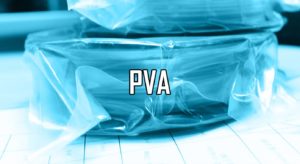PVA Filament – What is it used for? How to print?

Perhaps you have already come across the term PVA filament in your search for the right 3D printer filament. What exactly is behind it and what this filament can be used for, we would like to answer these and some other questions in this article.
Where can I buy PVA filament?
You can also buy PVA filament on Amazon:
* Stand: 2024-04-21 / Bilder: Amazon API
Visit the following subpage of threedom if you want to know the PVA bestsellers:
Buy PVA Filament – Current Best Sellers
PVA Filament – What is PVA?
The abbreviation PVA stands for polyvinyl alcohol. This is a thermoplastic material whose original form is usually white or yellowish powder. Hydrolysis – a type of alkaline saponification – of polyvinyl acetate produces this plastic. Hydrolysis is the cleavage of a biochemical compound due to a reaction with water. PVA filament is resistant to almost all other solvents that do not contain water.
Polyvinyl alcohol forms good layers in 3D printing. At the same time, the material is emulsifying and adhesive. Furthermore, it is a water-soluble plastic and resistant to oils and greases. The melting point is only reached at a temperature of about 230 degrees Celsius.
Polyvinyl alcohol is used not only in 3D printing, but also in many other processes. For example, it is found in PET bottles, hairsprays, one-day hydrogel contact lenses, and various paper glues, among others.
What are the advantages of PVA in 3D printing?
Since PVA filament is easily soluble in water, it is popular for making support structures that will be removed later. During processing, there is hardly any odor, which can be considered positive. The filament is also characterized by high flexibility and tensile strength. However, the latter depends on the humidity that the print material may have absorbed. At the same time, however, the elasticity increases here. As already mentioned above, PVA is resistant to oils, greases and also organic solvents.
What are the disadvantages of PVA filament?
If PVA is exposed to too much humidity, it becomes soft and thus less suitable for printing. In such a case, you should let the material dry first. It would be of great advantage if your 3D printer has two extruders, as then the support structures can be printed simultaneously with the other object structures.
Application examples for PVA filament
PVA is used as a support material in the manufacture of 3D printed objects. This can then be easily removed after 3D printing has been completed. To do this, the printed object is placed in tap water, in which the support material then usually dissolves effortlessly. You can speed up the dissolving process by using lukewarm tap water for dissolving. Since PVA is biodegradable, the water can be poured into the wastewater normally.
Of course, you can also print flexible objects yourself with PVA. In such a case, however, you should make sure later that they do not come into contact with water.
What settings are used to print PVA filament?
For 3D printing with PVA support structures, it is best to use the same settings for PVA and ABS. As already mentioned, however, a second extruder is almost indispensable.
The following settings would be conceivable:
- Printing temperature: 190 to 240 degrees Celsius,
- Print bed temperature: 0 to approx. 100 degrees Celsius,
- Possible printing speed: 20 to about 45 mm/s.
Is a heated print bed (heatbed) required in the 3D printer for PVA filament?
This does not depend on the PVA, but on the filament also used from which the object is to be printed. If you want to use ABS here, a heated print bed is necessary. But if you decide to use PLA, you don't need a heated print bed.
What should I pay attention to when storing PVA filament?
Like all other filaments, PVA should also remain in its original packaging until first use. Started coils are best stored in an airtight bag. For safety, each bag can also be added a little silica gel – known as an enclosure of handbags and shoes. This gel binds any moisture that may occur. The silica gel bags are also available in stores. We usually use silicate litter*, which is also used as cat litter.
The bags with the started PVA rolls should best be stored in a dark cardboard box or a plastic box and should not be exposed to light. PVA is dimensionally stable up to a temperature of about 55 degrees Celsius. It should therefore not be exposed to higher temperatures during storage. It is best to store the coils that are not currently needed in the study or elsewhere in the home in a somewhat darker place. The cellar, on the other hand, is the most unsuitable place for storage, as it is too humid.
